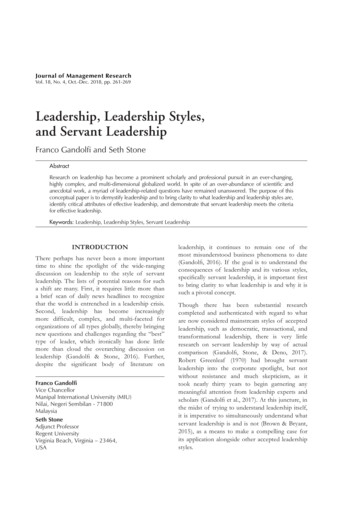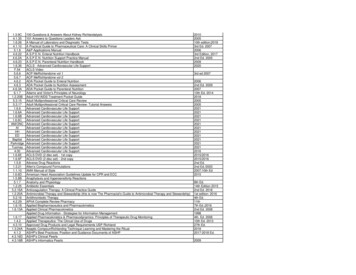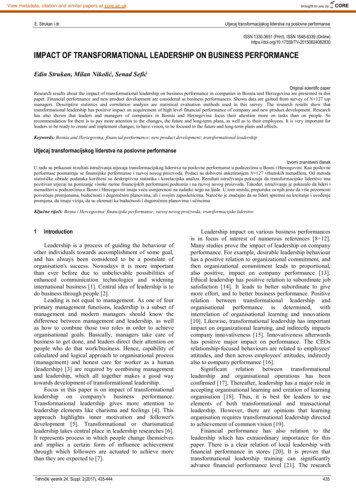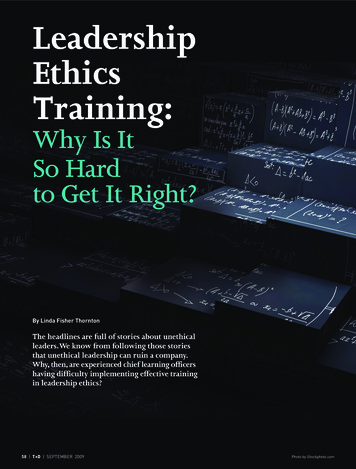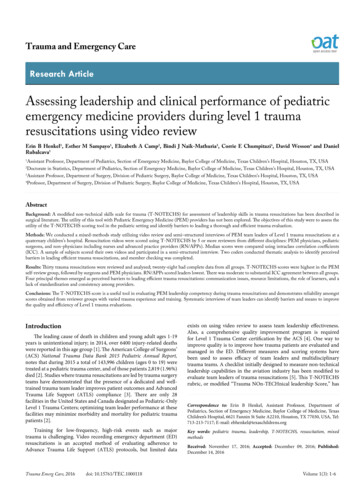
Transcription
Trauma and Emergency CareResearch ArticleAssessing leadership and clinical performance of pediatricemergency medicine providers during level 1 traumaresuscitations using video reviewErin B Henkel1, Esther M Sampayo1, Elizabeth A Camp2, Bindi J Naik-Mathuria3, Corrie E Chumpitazi1, David Wesson4 and DanielRubalcava1Assistant Professor, Department of Pediatrics, Section of Emergency Medicine, Baylor College of Medicine, Texas Children’s Hospital, Houston, TX, USADoctorate in Statistics, Department of Pediatrics, Section of Emergency Medicine, Baylor College of Medicine, Texas Children’s Hospital, Houston, TX, USA3Assistant Professor, Department of Surgery, Division of Pediatric Surgery, Baylor College of Medicine, Texas Children’s Hospital, Houston, TX, USA4Professor, Department of Surgery, Division of Pediatric Surgery, Baylor College of Medicine, Texas Children’s Hospital, Houston, TX, USA12AbstractBackground: A modified non-technical skills scale for trauma (T-NOTECHS) for assessment of leadership skills in trauma resuscitations has been described insurgical literature. The utility of this tool with Pediatric Emergency Medicine (PEM) providers has not been explored. The objectives of this study were to assess theutility of the T-NOTECHS scoring tool in the pediatric setting and identify barriers to leading a thorough and efficient trauma evaluation.Methods: We conducted a mixed-methods study utilizing video review and semi–structured interviews of PEM team leaders of Level 1 trauma resuscitations at aquaternary children’s hospital. Resuscitation videos were scored using T-NOTECHS by 5 or more reviewers from different disciplines: PEM physicians, pediatricsurgeons, and non-physicians including nurses and advanced practice providers (RN/APPs). Median scores were compared using intraclass correlation coefficients(ICC). A sample of subjects scored their own videos and participated in a semi-structured interview. Two coders conducted thematic analysis to identify perceivedbarriers in leading efficient trauma resuscitations, and member checking was completed.Results: Thirty trauma resuscitations were reviewed and analyzed; twenty-eight had complete data from all groups. T-NOTECHS scores were highest in the PEMself-review group, followed by surgeons and PEM physicians. RN/APPs scored leaders lowest. There was moderate to substantial ICC agreement between all groups.Four principal themes emerged as perceived barriers to leading efficient trauma resuscitations: communication issues, resource limitations, the role of learners, and alack of standardization and consistency among providers.Conclusions: The T-NOTECHS score is a useful tool in evaluating PEM leadership competency during trauma resuscitations and demonstrates reliability amongstscores obtained from reviewer groups with varied trauma experience and training. Systematic interviews of team leaders can identify barriers and means to improvethe quality and efficiency of Level 1 trauma evaluations.IntroductionThe leading cause of death in children and young adult ages 1-19years is unintentional injury; in 2014, over 6400 injury-related deathswere reported in this age group [1]. The American College of Surgeons’(ACS) National Trauma Data Bank 2015 Pediatric Annual Report,notes that during 2015 a total of 143,996 children (ages 0 to 19) weretreated at a pediatric trauma center, and of those patients 2,819 (1.96%)died [2]. Studies where trauma resuscitations are led by trauma surgeryteams have demonstrated that the presence of a dedicated and welltrained trauma team leader improves patient outcomes and AdvancedTrauma Life Support (ATLS) compliance [3]. There are only 28facilities in the United States and Canada designated as Pediatric-OnlyLevel 1 Trauma Centers; optimizing team leader performance at thesefacilities may minimize morbidity and mortality for pediatric traumapatients [2].Training for low-frequency, high-risk events such as majortrauma is challenging. Video recording emergency department (ED)resuscitations is an accepted method of evaluating adherence toAdvance Trauma Life Support (ATLS) protocols, but limited dataTrauma Emerg Care, 2016doi: 10.15761/TEC.1000118exists on using video review to assess team leadership effectiveness.Also, a comprehensive quality improvement program is requiredfor Level 1 Trauma Center certification by the ACS [4]. One way toimprove quality is to improve how trauma patients are evaluated andmanaged in the ED. Different measures and scoring systems havebeen used to assess efficacy of team leaders and multidisciplinarytrauma teams. A checklist initially designed to measure non-technicalleadership capabilities in the aviation industry has been modified toevaluate team leaders of trauma resuscitations [5]. This T-NOTECHSrubric, or modified “Trauma NOn-TECHnical leadership Score,” hasCorrespondence to: Erin B Henkel, Assistant Professor, Department ofPediatrics, Section of Emergency Medicine, Baylor College of Medicine, TexasChildren’s Hospital, 6621 Fannin St Suite A2210, Houston, TX 77030, USA, Tel:713-213-7117; E-mail: ebhenkel@texaschildrens.orgKey words: pediatric trauma, leadership, T-NOTECHS, resuscitation, mixedmethodsReceived: November 17, 2016; Accepted: December 09, 2016; Published:December 14, 2016Volume 1(3): 1-6
Henkel EB (2016) Assessing leadership and clinical performance of pediatric emergency medicine providers during level 1 trauma resuscitations using video reviewbeen validated for use in assessing team leadership in adult traumaresuscitations [5]. Studies using this tool have demonstrated thathigher leadership scores correlate with better clinical performance,shorter time to disposition, and fewer unreported resuscitation tasks[5,6]. Studies evaluating trauma leadership and completeness of traumaresuscitations led by Pediatric Emergency Medicine (PEM) physiciansare sparse. The purpose of this study was to objectively assess teamleadership of PEM physicians utilizing the T-NOTECHS scoring toolin the pediatric setting, and identify barriers to leading a thorough,complete and timely trauma evaluation.leader upon arrival. General pediatricians and APPs do not lead Level 1trauma resuscitations. Upon activation of a Level 1 trauma, respondingproviders include a minimum of one PEM physician, one PEM fellowif present, one pediatric or EM resident, a pediatric surgery attendingand/or fellow, pediatric surgery residents and/or advanced practiceproviders, respiratory therapists, trauma certified nurses, patient careassistants, a child life therapist, a social worker, and a chaplain. TheInstitutional Review Board for Baylor College of Medicine approvedthis study prior to initiation with waiver of informed consent grantedfor both providers and patients and their families.MethodsQuantitative design and analysisThis mixed-methods study was conducted in the ED of an urbanquaternary-care children’s hospital with Level 1 Trauma Centeraccreditation by the ACS starting in 2010. In 2015, this ED had anannual census of over 76,000 children ages 0 to 21-years-old; 12,294cases of injury per year were seen (16% overall census volume), 276(2.7%) of which resulted in full trauma team activation (Level 1activation). Level 1 trauma activations are based on standard ATLS andACS guidelines, including vital sign instability for age, low or decliningmental status, penetrating injury to the head/neck or torso, andrespiratory compromise. The most common mechanism of injury seenat this facility was blunt trauma, including non-accidental trauma. Theaverage length of stay for a trauma patient was 2.7 days, and mortalitywas 1.4% of all Level 1 trauma patients seen (4 out of 276 patients). The51 bed ED is staffed with a minimum of two PEM certified physicians,0-2 PEM fellows, 2 general pediatricians, 2-6 pediatric or emergencymedicine (EM) residents, and 0-3 advanced practice providers (APPs)at all times. ED trauma resuscitations are initially lead by PEM-certifiedphysicians and/or PEM fellows with attending supervision. A pediatricsurgery attending and/or fellow is expected to be present at theresuscitation within 15 minutes of patient arrival, and takes over as teamBetween May 1, 2014 and May 31, 2015, video and audiorecordings of Level 1 trauma resuscitations were collected frompreviously installed automated overhead video recorders in the EDresuscitation room. A convenience sample of 30 videos was selectedto capture seasonal variations, a representative sample of a variety ofteam leaders, and a variety of trauma mechanisms and severity. Weexcluded videos with inadequate video or audio quality that wouldprohibit complete review. The recordings were reviewed and scoredby a minimum of one PEM provider, one pediatric surgeon, and onetrauma RN/APP. All reviewers were ATLS or Trauma Nursing CoreCourse (TNCC) certified. The videos were reviewed for fifteen minutes,or until the primary and secondary surveys of the trauma evaluationwere completed, whichever came first. Each reviewer completed theT-NOTECHS leadership tool (Figure 1), which includes five Likertbased questions that can be analyzed individually and summed.Descriptive factors were presented using frequencies and percent.Continuous variables were found to be skewed using the Shapiro-Wilktest for normality, therefore medians and interquartile ranges wereprovided. To assess reviewer consistency among all three groups, theFigure 1. T-NOTECHS Scoring Tool.Trauma Emerg Care, 2016doi: 10.15761/TEC.1000118Volume 1(3): 2-6
Henkel EB (2016) Assessing leadership and clinical performance of pediatric emergency medicine providers during level 1 trauma resuscitations using video reviewFleiss’ Kappa statistic was chosen and intra-class correlation coefficient(ICC) calculated for paired scores in a post hoc analysis. Interjudgereliability with Fleiss’ Kappa and ICC was assessed using a randomselection of T-NOTECH scores from each reviewer group. Videoswithout complete data were excluded. ICC was analyzed using a twoway random model or mixed model with absolute agreement. Singularmeasure ICC values were reported along with 95% confidence intervals.Team leaders in 16 of the trauma resuscitations were asked to selfreview their own videos and complete the same scoring tool (Figure 1).Complete data were available for 15 videos, and ICC was performedcomparing the PEM team leader self-scoring to the PEM reviewers’also using random scores for these videos. All analyses were conductedby using the Statistical Package for the Social Sciences (SPSS) version23 software (IBM Corp., Armonk, NY) and Microsoft Excel 2013.Qualitative design and analysisSemi-structured interviews of a purposive sampling of PEMproviders who reviewed and scored their trauma resuscitation videoswere conducted and recorded. Audio was entered into NVivo Version 9.0(QSR International, Doncaster, Victoria, Australia) and analyzed usingan iterative coding process to identify principle themes. Researchersused constant comparison analysis, whereby they repeatedly listened tointerviews, formulated an initial framework of key codes, and refinedthese codes with successive reviews. Transcribed notes from interviewswere coded by two members (EBH, EMS) of the study team to allowfor investigator triangulation. The two members developed mutuallyagreed-upon definitions for each code and established examples of eachcode to ensure reliability and trustworthiness. The same two membersmet to discuss the qualitative findings and develop themes from thecodes. Memos of coding decisions were kept to provide consistencyin coding as analysis progressed. Member checking was performedto review themes and to check for accuracy and completeness of thefindings. The thematic approach is a widely utilized process in theanalysis of qualitative data [7]. This approach was used to identify aconceptual framework of themes related to perceived system andprovider barriers in the observed setting. Content saturation in thesemi-structure interviews was achieved when no new themes emergedin successive interview transcripts, which was found after 16 interviews.ResultsQuantitative resultsThe 22 PEM providers observed in the 30 videos leading traumaresuscitations had a self-reported range of Level 1 trauma experiencefrom 1-12 years, with a median value of 3.5 (2.0, 8.0) years (Table 1).Of the 30 videos reviewed, 28 had complete T-NOTECHS surveysfrom all three groups of reviewers, of which randomly selected scoreswere compared (Table 2). Minimum and maximum scores obtainableon this tool are 5 and 25, respectively. Results from the T-NOTECHSTable 1. Descriptive Characteristics of PEM Providers and Patients from Reviewed Videos.FactorPEM Providers (N 22)Female providersYears of trauma experiencePatients (N 30)N (%) or Median (IQR)16 (72.7%)3.50 (2.0, 8.0)Age (years)4.0 (0.975, 10.25)Blunt trauma24 (80.0%)Died in ED3 (10.0%)Died in hospital8 (26.7%)PEM Pediatric Emergency Medicine; SD standard deviationTrauma Emerg Care, 2016doi: 10.15761/TEC.1000118Table 2. Randomly Selected T-NOTECHS Scores across the Four Rating Groups.Video NumberPEMSurgeonRN/APPPEM 15261918152719121628151017291721133012211921RN/APP Registered Nurse and Advanced Practice Providersanalysis are summarized on Tables 3 and 4. In an analysis of Fleiss’Kappa inter-rater reliability between groups on the five sections ofthe T-NOTECHS tool, there was poor to fair agreement between allthree groups (ĸ range 0.03-0.25) with the strongest agreement in theleadership category (ĸ 0.25) (Table 3). Summed T-NOTECHS scoresshowed very low agreement (ĸ 0.02) (Table 3). A post hoc reliabilityanalysis comparing PEM provider training was fair between surgeonsand RN/Midlevel (ICC 0.27) and moderate between PEM and RN/Midlevel groups (ICC 0.55) (Table 4). Self-review by PEM teamleaders had a moderate agreement (ICC 0.49) (Table 4).Qualitative results16 PEM team leaders self-reviewed his or her video and completeda semi-structured interview with the primary investigator (EBH). Fourprincipal themes emerged as perceived barriers to leading efficienttrauma resuscitations: communication issues, resource limitations,the role of the learner, and lack of standardization (Figure 2). Selectedquotes organized by theme can be found in Table 4.Communication issuesCommunication barriers were a major theme discussed in allinterviews. Concerns included difficulty with handoff from EMS,communication amongst the ED team members, challenges balancingteam lead responsibilities, crowd control, and discussions with thesurgical teams and/or the pediatric intensive care unit.With the initial EMS handoff, several providers noted difficultywith “distractions” during this time. “It was hard to listen to the medics[give report] People do not totally respect the position you’re in.”Volume 1(3): 3-6
Henkel EB (2016) Assessing leadership and clinical performance of pediatric emergency medicine providers during level 1 trauma resuscitations using video reviewTable 3. Inter-Rater Reliability of PEM, Pediatric Surgeons and RN/APPs in EvaluatingLeadership Performance in the Emergency Department using Randomly SelectedT-NOTECHS Scores. (N 84).team leaders reflected as going well, they often cited pre-notification asthe reason for efficiency and the “key to success.”T-NOTECHS Item (Range)Another commonly cited resource limitation was lack of or delayin radiology services, noted in 13 of the 16 interviews, such as timerequired to upload and view imaging sent from transferring facilities,availability and timeliness of X-ray technicians to the bedside, andtimeliness of results from CT scans.Fleiss Kappa* 95% Confidence IntervalLeadership (1-5)0.250.01 – 0.48-0.14 – 0.30Cooperation and Resource Management (1-5)0.08Communication & Interaction (1-5)0.13-0.11 – 0.37Assessment & Decision Making (1-5)0.03-0.19 – 0.25Situation Awareness/Coping with Stress (1-5)0.06-0.17 – 0.30Combined Likert Score (5-25)0.02-0.09 – 0.14PEM Pediatric Emergency Medicine PhysiciansRN/APPs Registered Nurses and Advanced Practice ProvidersTable 4. Intra-class Correlations Reliability Analysis Using Paired T-NOTECHS LikertScores Randomly Selected (N 28).Paired Group ComparisonICCa95% Confidence IntervalaPEM vs. Surgeon0.500.18 – 0.73Surgeon vs. RN/APP0.27-0.06 – 0.56PEM vs. RN/APP0.550.23 – 0.76PEM vs. PEM self0.490.04 – 0.79NOTE: ICC intraclass correlation coefficient; PEM pediatric emergency medicine; RN registered nurse; APP advanced practice provider.aSingle measures Intra-class Correlation and 95% CIs provided.Additional system limitations mentioned included readiness ofoperating rooms and staffing, pediatric intensive care availability, andstaffing of the emergency department.Role of the learnerMany PEM team leaders, 12 of 16, discussed the role of differenttypes and levels of learners present and participating in the traumaevaluations, including pediatric residents, emergency medicineresidents, PEM fellows, surgery residents, and surgical subspecialtyresidents. Timeliness of ATLS completion as well as thoroughnessof primary and secondary survey completion was perceived to beimpacted by the learner’s previous experience with ATLS and years oftraining. Quantity of learners present and the role of each individual atbedside was noted as “always challenging.” PEM team leaders reportedstruggling with attempting to balance learning opportunities withefficiency.The PEM senior fellows interviewed who functioned as team leadersnoted occasional difficulty with leadership when they functioned asteam lead due to the duality of their role as both leader and learner withthe PEM attending also present. Fellows noted feelings of “confusion,”a “tug of war” and in some circumstances “flipping” from their role asteam leader at some point during the evaluation and management oftheir patients.Lack of standardizationFigure 2. Conceptual Framework of Barriers to Efficient Trauma Resuscitations.Furthermore, “crowd control” was often cited as a concern. Because“we’re a teaching institution” and a have many participants involvedin trauma evaluations, “noise levels” and “crowding” were noted asbarriers to efficient communication.Communication concerns with other team members from pediatricsurgery, neurosurgery and other surgical subspecialists were noted inall interviews. Later arrival of the surgical team(s) was a frequentlyidentified barrier that contributed to gaps in communication betweenservices.Resource limitationsResource limitations of varying types were discussed in allinterviews. Providers in 11 of 16 interviews cited concerns with theexisting pre-notification system and variations in the quality andtiming of information available to them. Conversely, in traumas thatTrauma Emerg Care, 2016doi: 10.15761/TEC.1000118Although ATLS is taught as a standardized process, PEM teamleaders in all interviews revealed that they perceive a significantvariation between providers, including PEM and surgical practices.Several providers noted specific actions that are frequently missed ortake significant time and energy to obtain, including temperature, bloodpressure, a fully disrobed exam, and FAST exams. They also stated thatsome providers have increased “confidence” with trauma, while otherswho do not may struggle with timeliness and consistency. Additionally,themes centered on the fact that PEM providers often struggle withbalancing instincts to minimize invasiveness and diagnostic testingversus strictly following an algorithmic process and ordering morestudies and imaging than may be necessary. “We try not to do a lot ofstuff and that puts us in trouble when you start to second guessthe rules.”Given the fact that, in our institution, the surgical services are notphysically present in the ED at all times, there was also a theme ofpotential variation, “conflict,” or “discord” in management related tothe timing of the pediatric surgery team arrival as well as subspecialtysurgical consultants. Individual roles, decision making and transitionof care were noted to be most clear and seamless when pre-arrivalnotification allowed the surgical services to be present at the arrival ofthe patient and initiation of trauma evaluation.Member checking with nine PEM physicians and fellows confirmedthe above findings. The conceptual framework of codes and themes(Figure 2) was found to be consistent and reproducible.Volume 1(3): 4-6
Henkel EB (2016) Assessing leadership and clinical performance of pediatric emergency medicine providers during level 1 trauma resuscitations using video reviewTable 5. Select quotes from semi-structured interviews, organized by theme.ThemesIllustrative QuotesCommunication BarriersInterviews (x/16)16/16Roles and Team Lead“We got so off course that there wasn’t good closed-loop communication. I don’t think I summarized or gave a shared mental model14/16as I should or normally do. I don’t think we verbalized roles well. We got caught up in the stressful not-normal situation and that was abarrier.”“There were a lot of distractions It was hard to listen to the medics [give report] while someone else is trying to tell me something else.People do not totally respect the position you’re in, trying to get check out, you often have a lot of distractions We need to educate oneanother to respect the time [of handoff] and listen to the history.”“I was trying to be team lead, but also talk to mom to verify code status and limits of the resuscitation. It was challenging because [thefellow] was focusing on the airway if you get a second attending in the room to take over the rest of the ER grinds to a halt.”Crowd Control“At one point we had 3-4 surgeons, 4 PEM physicians, nursing staff, techs, X-ray techs, a pharmacist, a scribe there were a lot of9/16people not actively doing things on the patient who could have taken a step back. This would have helped with noise level.”“People get excited and the noise level is immense. Doing crowd control and being the team lead is difficult Also needing tocommunicate with the family [Others] can help with this, but eventually the team leader needs to be the face of the person taking careof their child.”Handoffs“Getting ready to mobilize to the OR was the issue With surgery, anesthesia and us [PEM] there, the nurse said ‘who do we take orders 16/16from?’ The transition of care from ER to surgery was fragile. there was some back and forth, confusion Also with anesthesia, theywanted blood labs now, then surgery said ‘no we don’t need those here,’ there was back and forth.”16/16Resource LimitationsPre-arrival notification“The onus should be on the system, not the individuals, to be aware of incoming trauma. We could benefit from a more systematic way of 11/16notifying both [PEM] attendings and fellows. Often it’s one and not the other. The overhead page of a trauma arrival is not optimal.”“The key for this trauma running well was pre-notification: both surgery and neurosurgery were present upon arrival, the surgeryattending was right next to me. We had no delay.”Radiology demands“From when the patient arrived to when the CT was uploaded took 30 minutes or more. At one point neurosurgery and I discussed if we 13/16should just re-scan the head. This delayed care. The second it was uploaded, they said ‘go to the OR’, but they didn’t want to move untilit was available.”“To be a trauma center and not have X-ray in the room, that just seems wrong. In this case we got an airway, couldn’t get an X-ray for 15minutes. Our radiology [resources] leave more to be desired.”Infrastructure“We need to push ourselves as the physician and push in an interdisciplinary way across the whole trauma system setup to get on point 16/16with getting people to places fast. Cat scan should be ready immediately. A radiologist should be ready immediately to read the scan.There needs to be a PICU bed or an OR as fast as possible.”“From an efficiency standpoint, we’re strapped. We’re trying to manage a large volume and high acuity of patients, and take transfercalls, and cover [trauma patients] considering having a dedicated trauma team would not be possible in our current staffing situation We could still improve notification and comfort level with trauma.”12/16Role of the LearnerResident types“I think this is intrinsic to teaching institutions and always challenging – when fellows are doing the primary survey it’s much morecoherent than when the residents do it. Not so much if it’s an EM resident, but the pediatrics residents. They don’t always step up to dothe evaluation if they’re not comfortable. Maybe this needs more directed teaching with these residents.”“A lot of decisions on the surgery side are made by residents with very little pediatric trauma experience.”“There is this running the information up and down the flagpole with those [on surgical teams] who aren’t present.”PEM fellow role“[My role as a fellow as team lead] eventually became nonexistent in that situation, and in others, once the [attending] starts to take6/16over, rather than cause that confusion and tug of war, I then quiet down, step back and let them take over There is a point where I giveit up I could have asked to continue leading or officially transferred over the role. I’ve done both. ”“That’s really when things really got lost. I could have decided to say this is my role [as team lead] or not At that point the role [ofteam lead] flipped We were doing things in parallel, separately without communicating with each other.”ATLS experience“We should focus on getting the assessment started faster, not just in this case, I think it’s a chronic problem. We don’t start the8/16assessment with a pace or urgency commensurate with a Level 1 trauma center that sees unstable trauma patients We should besimultaneously be addressing issues as they are identified.”“We could have used this as a better learning opportunity. No one believes that any further interventions would have saved this child orchanged the outcome In this situation the greater good is training and knowing we did everything.”16/16Lack of Standardization10/16ATLS protocols“The beauty of ATLS is that it’s supposed to be so standardized, [but] there’s quite a bit of variability within our section. How the timing 16/16of primary and secondary are carried out, the way in which they are verbalized and documented in the trauma nursing documentation.”“An area of confusion is who is going to do [the secondary survey] if it’s time for the secondary survey and we don’t see the surgicalteam, we don’t want to wait if they come in the middle of the secondary, it’s a point of confusion- do we hand it off? Start over?”“Our FAST exams are improving but there may be some variation in how well we do those in this case an EM resident performed theFAST. There are different comfort levels.”“Trauma is so regimented. I’m not saying forget common sense. But if you don’t always follow your pathway, there’s tendency to misssomething This is the biggest limitation for pediatric trauma: we try not to do a lot of stuff. That puts us in trouble when you start tosecond guess the rules.”Provider experience“ATLS clearly defines who is to be in charge in various roles. There are PEM providers and fellows who have a varied experience with 12/16pediatric trauma compared to the surgeons. There is a personality of provider that certain traumas run seamlessly and effortlessly. Someof the changes in decision making when surgery arrives later, and depending on who was initially running the trauma, is a communicationissue. It changes based on provider.”Surgical roles“The biggest challenge is making sure consults are available – not calling if they are not needed, but getting them at the bedside quickly 16/16if we do [need them].”“The goal is to streamline the balance of the balance of transition between [PEM and surgery] team leaders If surgery arriveslater and we have already completed primary and secondary, they often repeat it even if the results are communicated. I understandthoroughness, but sometimes the two teams can run in parallel and not in tandem If surgery is present from the beginning, those rolesare more clearly delineated.”Trauma Emerg Care, 2016doi: 10.15761/TEC.1000118Volume 1(3): 5-6
Henkel EB (2016) Assessing leadership and clinical performance of pediatric emergency medicine providers during level 1 trauma resuscitations using video reviewDiscussionThis is the first known study assessing the T-NOTECHS tool in thepediatric-specific setting and demonstrating its validity and reliability,with moderate agreement between PEM physicians and surgeons, aswell as between PEM physicians and RN/APP groups. These are threegroups with diverse training and experience in caring for pediatrictrauma patients. We expected the PEM scorers to give the highestscores to their peers whose performance they were assessing; but, wefound instead that the surgeon group rated the PEM providers withhigher T-NOTECHS scores. As reported in other studies with selfreview, the self-scoring group rated themselves highest, demonstratinga bias towards stronger performance when reviewing their own videos.The surgeon group scored the PEM team leaders highest of thethree independent groups, while the nursing and APP group scoredthem the lowest. This raises the question of why the RN/APP group feltthat leadership was lacking. We presume that the perception of qualityof leadership is largely based on the training and experience of thereviewer, in this case three reviewer groups with very different trainingin caring for pediatric trauma. The surgeon group may be focusingon efficiency, speed and completeness of the ATLS protocols, whilenursing may be more focused on communication skills and ov
Erin B Henkel 1, Esther M Sampayo, Elizabeth A Camp2, Bindi J Naik-Mathuria3, Corrie E Chumpitazi1, . leadership capabilities in the aviation industry has been modified to . 23 software (IBM Corp., Armonk, NY) and Microsoft Excel 2013.


